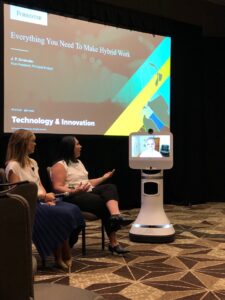Hybrid Work Requires Experimentation

Forrester’s recent experiment in hybrid delivery
Two-thirds of companies have adopted some form of anywhere work. A majority have implemented hybrid work, a version of anywhere work in which employees come into the office at least weekly. But as we detail in our newest report in our anywhere-work series, Master The Messy Middle Of Hybrid, the road to hybrid success is riddled with speed bumps. Too often, organizations end up with doubtful leaders; dissatisfied middle managers; frustrated employees; and an unfulfilled need for new processes, technologies, and culture.
It’s all a work in progress.
Anywhere work will continue to test leaders and employees for years to come. Mastering hybrid will require organizational innovation. And achieving that innovation requires experimentation: trying out new practices that employ new technologies and challenge cultural norms.
Forrester Recently Experimented With Hybrid Delivery
We decided to take our own advice and experiment. I’ve been leading our research on anywhere work, but I’ve been unable to travel due to high risk and long-COVID complications. Yet we wanted to include my research in our Technology & Innovation North America Forum in Austin. So how could we incorporate me into the program in a compelling (but hybrid) fashion?
Enter Ava Robotics, a Massachusetts-based iRobot spin-off offering telepresence, disinfecting, and security robots. Ava Robotics provided a telepresence robot that allowed me to “attend” and participate in the event. (The company’s CEO, Youssef Saleh, also sat on our in-person panel discussion.)

Author (via telepresence) with the leader of Forrester’s future of work team, panel moderator James McQuivey, PhD
Telepresence Deepened My Remote Participation Experience
The goal of the session was for me to participate in a relatively natural way using technology. The telepresence robot:
- Took the place of my human body. The robot participated much like a human. The audiovisual engineer miked up the robot, just like the human panelists. It moved around the room: I gave a 5-minute presentation with PowerPoint slides with the robot planted in one location, then navigated over to “sit” with the human panelists. The screen dropped down to their level, as if sitting down. And I could see my co-presenters and the audience through cameras, just as they could see my face on screen. It wasn’t “Avatar,” but it gave me a spatially aware sense of presence reminiscent of real-world attendance.
- Interacted with humans in the room. We could have projected my face onto the overhead screen where PowerPoints appear. But I wouldn’t have been “part” of the panel; the human panelists and moderator would have had to glance up at the screen unnaturally, and I wouldn’t have seen them at all. The telepresence robot allowed the moderator and panelists to address me directly, looking at my face (and into the camera), which created a simulated sense of presence and a more natural interaction.

The telepresence robot sat on the panel, just like the human participants
Hybrid Innovations Require New Norms
Telepresence robots have been around for a few years; I saw them at big technology conferences pre-COVID. Some early vendors have consolidated: GoBe bought Beam, an early market player. But they’ve never become commonplace. The Ava Robotics solution performed well technically, but its success will require new norms:
- New technology requires familiarization. At our event, it was clear that even many Forrester analysts hadn’t seen a telepresence robot in person. Clients tended to approach the robot and look at it with curiosity. But none of them engaged with it as if I were there in person; the unfamiliar technology held them back. By contrast, colleagues approached the robot and saw my (familiar) face, which lowered their inhibitions. They said hello and engaged with me.
- Familiarization breeds new norms. With more exposure, psychological comfort will grow. Over time, people will develop norms that dictate how to behave around telepresence robots. But the process will take time and — yes, again — lots of experimentation.
Telepresence Is Just One Of Many Experiments You Should Try
Telepresence robotics ably fulfilled a need for our event, and so we tried it. This technology may or may not fit a need that you’re experimenting to fill. The same is true for other technologies. In The Forrester Tech Tide™: Enterprise Collaboration Technologies, Q3 2022, we identify five technologies to experiment with (like the metaverse) and seven that you should invest in today (like in-room whiteboarding).
Ultimately, combining new technologies with human factors — norms, culture, leadership, experience — offers powerful tools for making hybrid work. Don’t expect overnight success. But taking some bold risks will push your company along the learning curve faster, and Forrester is here to help guide your journey.
J. P. Gownder is a vice president and principal analyst on Forrester’s future of work team.
